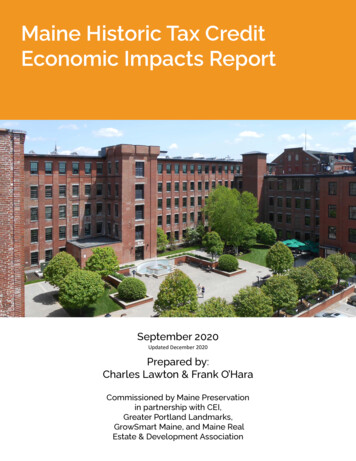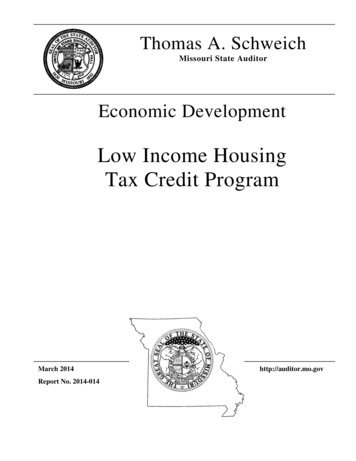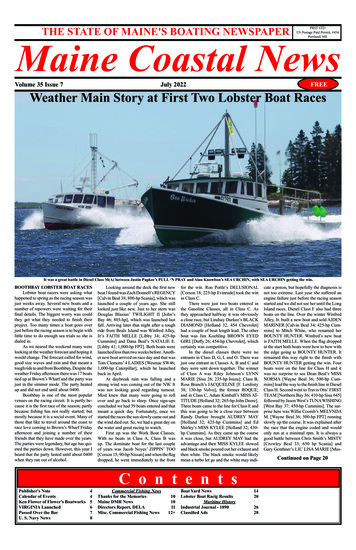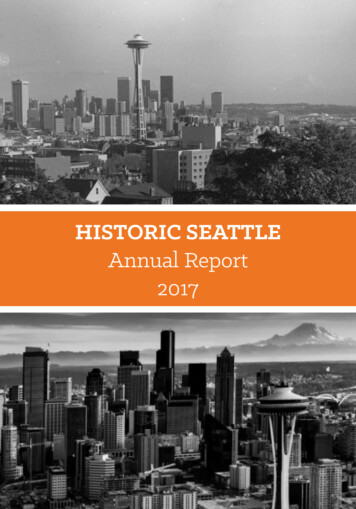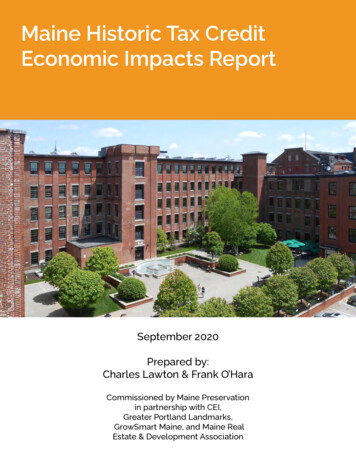
Transcription
Maine Historic Tax CreditEconomic Impacts ReportSeptember 2020Prepared by:Charles Lawton & Frank O’HaraCommissioned by Maine Preservationin partnership with CEI,Greater Portland Landmarks,GrowSmart Maine, and Maine RealEstate & Development Association
About the AuthorsChuck Lawton received a Ph.D. in economics from Tufts University.He is the former director of the Economic Development Division ofthe Maine State Planning Office, where he built Maine’s first computermodel for regional impact analysis. Chuck is also a former partner inPlanning Decisions, Inc., where he conducted economic impact studiesfor Maine industries as diverse as potatoes, biomedicine, and horseracing; and analyzed the effectiveness of state economic developmentand broadband programs. Chuck has authored two prior analyses of theimpact of the state historic tax credit over the past decade. Chuck canbe reached at cttlaw3@gmail.com.Frank O’Hara is also a former principal of Planning Decisions, Inc.,with a specialty in community development, housing, and economicdevelopment. O’Hara is the author of numerous state economic studiesand reports including, most recently, the Maine Economic DevelopmentStrategy 2020-2029. O’Hara has also worked with Lawton on both prioranalyses of the historic tax credit in Maine. Frank can be reached atfrankomaine@gmail.com.The data in this report spans 2008-2019.Cover image: Lofts at Bates Mill, LewistonEditorial: Coastal Enterprises, Inc. (CEI) and Maine PreservationDesign & Layout: Kate Burch, Greater Portland LandmarksPhotographs: Maine Preservation’s Honor Awards 2020 Maine Preservation
Table of ContentsExecutive Summary11. What is Maine’s Historic Tax Credit (HTC)and how does it work?32. How has the HTC beneficially impactedMaine’s economy?53. What has been the fiscal impact of theHTC program?104. What are the likely impacts of the HTCprogram in the future?13Appendix A: Measuring “New Jobs”15Appendix B: Case Studies16
Gerald Hotel, FairfieldExecutive SummaryThe Maine Historic Tax Credit (HTC) incentivizes business and real estate owners anddevelopers to rehabilitate and reuse income-producing historic buildings in Maine. Thetax credit encourages investment in downtown areas to spur revitalization, and to createaffordable housing. The mechanism is complicated (see Section 1). The net result is thata building owner or developer can receive a state tax credit of 25%, or 34% for affordablehousing, of the cost of historic improvements for the rehabilitation and reuse of a building thatis a “certified historic structure.” The credit is limited to no more than 5 million per project peryear for 4 years.The Credit was substantially expanded in 2008, and immediately, despite the Great Recession,its use took off and has continued. From 2009 to 2019, 106 projects were certified and placedin service in Maine. There are another 59 in various stages of approval.Combined, these 106 approved projects: Generated 525 million in construction investment; Rehabilitated 3.6 million square feet of commercial and residential space; Created or preserved 1,911 housing units, of which nearly 1,300 were affordable; and Generated 200-700 full-time-equivalent (FTE) jobs through construction spending aloneannually for the past decade.Additionally, nearly 700 new full-time, year-round jobs have been generated by businesses1
occupying commercial spaces and in building maintenance, generating 13 million per year inongoing income to families living in these communities.These renovations have added over 166 million to local property tax rolls in hostcommunities, including 17 million in new property tax payments since 2010. The HTCprogram has become a major local revenue-sharing program in its own right. Another 19million in new income and sales tax revenues are estimated to have come into state cofferssince 2008. To date, the program has generated 3 million more in state and local taxrevenues than it has cost in tax credits. The program passed into net positive fiscal territory in2016 and is expected to continue to provide net benefits in the future.Currently, of the additional 59 projects that have been partially approved for the HTC, 16 areunder construction. These projects are located in communities large and small, and spreadwidely across Maine– from Sanford to Rangeley and Dover-Foxcroft to Eastport. Based onpast experience, most partially approved projects will be approved, built, and occupied within adecade. We estimate that the net economic benefit to Maine state and local governments willdouble to at least 6 million annually by 2022.Beyond the numbers, Maine’s Historic Tax Credit fulfills the state’s economic developmentgoals as outlined in the Maine Economic Development Strategy 2020-2029: Provides needed affordable housing for Maine families and seniors; Creates in-town housing that is attractive to young singles and couples who areimportant to our workforce; Incentivizes development of housing located within walking distance of downtownstores and services, reducingdependence on motorizedtransportation and decreasingMaine’s carbon footprint; Promotes downtownrevitalization in distressedcommunities; and Helps communities retain theiridentities and “quality of place”by preserving distinctive andlandmark buildings in town.2Press Hotel, PortlandThough this report focuses oneconomic impact, the substantialclimate change benefits ofrepurposing embedded carbon in thebuilding materials reused in theseprojects, compared with demolitionand new construction, must also beacknowledged when measuring theoverall value of the tax credit.
1. What is Maine’s Historic Tax Credit(HTC) and how does it work?Hathaway Creative Center, WatervilleIn 2008, the Maine Legislature substantially strengthened state tax credits to facilitate therehabilitation of historic buildings across the state.1 The goals of the historic tax credit programare to stimulate investment in and revitalize downtowns by upgrading and reusing underutilizedvacant and blighted buildings and develop affordable housing for Maine residents. Theprogram increases the commercial and residential use and value of historically significantproperties while maintaining the essential visual, structural, and cultural characteristics thatmake eligible properties significant. By preserving these properties for future generations, theprogram provides a powerful tool for housing and economic development.To receive a state historic tax credit, a building owner must receive a three-part certificationreviewed by the Maine Historic Preservation Commission (MHPC) and the National ParkService (NPS) and receive a federal historic tax credit.2 This ensures that the impact of creditspaid out by the State of Maine is amplified by credits paid out by the federal government.Certification is a staged vetting process. In Part 1, a building must be certified as being ofnational, state, or local significance; in Part 2, rehabilitation plans have to be approved; andin Part 3, the Park Service must certify that the completed construction complies with theapproved plans.Projects must elect a completion timeframe of either 2 or 5 years. Upon completingcertification, a project becomes eligible for a Maine income tax credit. The credit is set at 25%of qualified expenses (those directly related to historic rehabilitation). Projects that create1In 2007 a tax incentive similar to the 2008 HTC was passed exclusively for the Hathaway Mill inWaterville.2Projects with qualified expenditures of 50,000 to 250,000 may apply for a Small Project RehabilitationCredit from the Maine Historic Preservation Commission which does not require also receiving a federal historictax credit.3
affordable housing3 were originally eligible for a credit of 30%. However, the law contained aprovision that, if the total square footage of new affordable housing created under the HTCprogram is less than 30% of the total square footage of all projects receiving an HTC credit,the credit may be increased. As a result of this provision, the affordable housing tax credit hasrisen to 34% in 2019. The law caps this increase at 35%. Thus, the fiscal incentive for and costof creating more affordable housing through the HTC program has increased gradually over theyears, but, short of additional changes to the law, will likely remain near or at the 35% cap overthe next several years.Regardless of the rate of the credit, the Maine HTC is now limited to 5 million per projectannually.4 This provision effectively establishes a 20 million project limit for each projectreceiving a 25% credit ( 20 million x 25% a 5 million credit per year over four years). Projectscan spend beyond this cap, even for otherwise “eligible expenses.” They simply do not receivethe state credit for the amount spent above the 20 million cap. For affordable housingprojects approved in 2019 at the 34% credit, the effective tax credit cap was 14.7 million.The Maine HTC is offered in equal installments in each of the four years following finalcertification. This process guarantees that credits will not be paid until projects are approvedand completed. To assure they are not only investing in the project but invested in thecommunity, project partners must remain owners for five years after Part 3 certification.As an example, a building owner presents a redevelopment plan to MHPC and NPS forapproval. After receiving Part 1 and Part 2 approvals, the owner begins spending onrehabilitation activities—buying materials, hiring contractors, etc. After the rehabilitation iscompleted—usually 18 to 24 months after the project begins—the ownership team submits aPart 3 application listing the total “qualified” expenses, say 4 million, for certification. If theseexpenses are approved by the Maine Revenue Services (MRS) and the federal Internal RevenueService as qualified rehabilitation expenditures, the owner can claim a state credit of 4 millionx 25% 1 million. This credit amount is returned to the owner or his/her designee in the formof a credit against his/her state income tax liability over each of the next four years at 250,000per year, and any amount above his/her tax liability is refunded.In addition, using the same approval process outlined above, recipients of the Maine HTC alsoreceive an additional 20% federal historic rehabilitation tax credit (applicable to federal incometax returns). Applications are filed jointly for both credits with the same reviews and approvalsdone in direct sequence. For Small Project Rehabilitation applications—those with qualifiedexpenses between 50,000 and 250,000—owners may opt for only the state credit and areapproved only by MHPC and MRS. For all other projects, state and federal historic creditstotal 45% (or currently 54% for affordable housing projects). The federal credit increases thefeasibility of potential rehabilitation projects. Unlike the Maine credit, the federal credit is nowmade available in the five years following project completion.53Affordable is here defined to mean that either at least 50% of the aggregate square feet of the completedproject is housing and that 50% of that housing is new affordable housing, or at least 33% of the aggregate squarefeet of the completed project creates new affordable housing.4The original cap of 5 million per project interpreted by Maine Revenue Services to apply to entire complexes of related historic buildings was amended in 2013 to permit this limit on an annual basis for each building.Prior to 2013 one project had exceeded this limit.5The entire federal credit was issued in the first year following project completion until the federal tax lawwas amended in 2017.4
2. How has the HTC beneficiallyimpacted Maine’s economy?Saco Island Apartments, Saco17 Alfred Street, BiddefordBetween 2009 and 2019, 106 projects have been certified and placed in service in 36municipalities across Maine.Figure 1Number of HTC projects in Maine2010-2019201816141210864201815103571289102010 2011 2012 2013 2014 2015 2016 2017 2018 2019Source: Maine Preservation; projects listed by “placed in service” date.Collectively, these projects have generated over 445 million in certified rehabilitation spendingand an additional 79 million in associated non-certifiable work and new construction, resultingin a total of 525 million invested to improve Maine properties since 2007. In addition, 56 of5
these projects involved mixed use and commercial activities that have created the full-timeequivalent of 700 new jobs in businesses located inside these renovated buildings. In addition,Maine has received an additional 80 million in funding from federal historic tax creditsallocated to these projects, which would otherwise not have come to the state.The HTC impact on Maine has three central components: It attracts complementary investments—amounts beyond that required by the tax credit; Its rehabilitation activities have indirect impacts6; and Its 56 commercial/mixed-use projects created operational activities (new sales forMaine businesses and new jobs for Maine workers located in the rehabilitated historicbuildings), and this new economic activity has its own indirect impacts.Complementary InvestmentsThe HTC program stimulates complementary investment in two ways.7 First, the majorityof projects include investment in new construction – additions that are not eligible forthe state historic tax credit but are completed in conjunction with the rehabilitation of thehistoric property. Second, most projects require spending for “ineligible expenses”—parking,landscaping, loan fees, etc.—thus ensuring that project spending exceeds tax credit-generating“eligible expenses.” These benefits are illustrated in Figure 2.Figure 2HTC Investment in Maine2009-2019( million) 90 80 70 60 50 40 8 30 20 10 0 37 1 1220092010 4 10 30 13 7 60 5 63 7 64 11 66 4 36 38 8 262011 15201220132014Certified Rehab. Expenses20152016201720182019Non-certified ExpensesSource: Maine Preservation. Totals listed were actually spent in the two yearsprior to the “placed in service” date.6Indirect impacts are the sales revenue flowing to Maine businesses in the vendor supply chain serving theconstruction industry and in the consumer sectors serving the employees of both the construction industry andits vendors.7HTC spending often stimulates investments by other property owners, developers and municipal governments in neighboring properties and local infrastructure. These neighboring properties are often vacant or underperforming. Thus, the HTC project serves as a catalyst for further investment and increases in property tax valuesin the neighborhood. In addition, HTC projects use existing community assets and infrastructure, such as roads,sewers, and power lines. They do not require municipal taxpayers to expand infrastructure, as often happens withnew construction projects. Estimation of the impacts of these “complementary” investments requires examination of activities not listed in HTC project records and is thus beyond the scope of this report.6
For every 100 spent on eligible historic rehabilitation expenses, another 18 was spenton new construction or other ineligible expenses – thus magnifying the constructioneconomic impacts of state historic tax credit projects.Indirect Impacts of HTC Investment ActivityHTC-generated construction and rehabilitation expenditures (both qualified and non-qualified)involve direct spending for planning, design and architectural services, banking and legalservices, and engagement of general contractors. These direct expenditures, in turn, setin motion economic ripple effects throughout the regions where they occur. Investors andproject managers hire contractors and trades people, engage building supply vendors, andtrigger numerous related supply chain commercial interactions that rehabilitation investmentsgenerate. At the same time, employees of both directly involved construction businesses andtheir supply chain vendors pay rent and mortgages, buy groceries, pay utility bills and propertytaxes, and spend on other household expenses. These direct and indirect impacts generallyoccur over the two years prior to a project’s “placed in service” date and end when the projectsare placed in service.Figure 4 (page 9) illustrates the annual impact of HTC-generated investment spending. Itassumes that a project’s total spending (certified and non-certified) occurs over the two yearsprior to its “placed in service” year. The value for 2007, therefore, represents one-half of thetotal spending for projects placed in service in 2009. The value for 2008 represents the otherhalf of the 2009 projects plus one-half of the value of 2010 projects. The subsequent yearsfollow the same pattern. The 2018 and 2019 figures include estimated spending of 37 millionfor 2020 projects and 42 million for 2021 projects.Figures 3 illustrates the year-to-year pattern, of direct HTC-generated investment spending andits indirect impact on Maine.Figure 3Direct & Indirect Impact ofHTC Investment Spending2007-2019( million) 140 120 54 100 0 47 36 60 20 59 47 80 40 56 28 23 18 232007 292008 59 67 70 74 32 59 25 45 17 35 32 3020172018 222009201020112012Total HTC spending2013201420152016 24 402019Indirect SpendingSource: Maine Preservation, Maine Historic Preservation Commission andIMPLAN model of Maine.7
Between 2007 and 2019, HTC-generated investment spending totaled 583 million. Thisspending supported additional vendor supply chain and employee spending in Maine of 466million. Thus, the total impact of HTC-generated investment spending in Maine has exceeded 1billion.For every 100 spent on historic rehabilitation expenses, another 80 flowed to Mainevendors and employees indirectly linked to the direct HTC investment spending–thusfurther magnifying the economic impacts of state historic tax credit projects.Rangely Inn, RangelyWhile actual spending has varied from year to year, on an average annual basis over this timeperiod, the HTC has supported the equivalent of 215 full-time construction workers and anequivalent number of indirect jobs.8Indirect Impacts of HTC–Generated Operational ActivityThe second source of broader economic impact flowing from HTC projects derives fromthe operational impacts of new and growing businesses that locate in Maine because of theopportunities presented by the HTC-initiated improvement of the buildings they now occupy.Notable examples of this phenomenon are Baxter Library in Portland (VIA Agency), a varietyof hotel/inn renovations (the Press Herald Building, the Eastland renovation, the ColonialInn in Ogunquit, the Fort McKinley Barracks) as well as mixed-use projects such as YorkManufacturing Mill #4 in Saco and the Jose Block in Portland.Using data on average employment per square foot by commercial sector and the IMPLANmodel for a combination of hospitality, restaurant, office and retail sectors, the authorsestimated employment, sales and the indirect impact of the 56 commercial and mixed-useprojects certified under the HTC program. In addition, unlike the “once and done” impact of8These numbers should not be interpreted as specific people hired to do specific “jobs.” In fact, they represent the total number of “job equivalents” filled by thousands of people in hundreds of businesses part of whosesales derive, ultimately, from HTC-generated investment spending. Both the spending and the “job equivalents”rise as more HTC projects are undertaken and fall as they are completed.8
investment spending, operating sales, employment, and expenses recur year after year as longas the “new-to-Maine” business activity continues. Thus, like the recurring property tax revenueflowing to the HTC host communities (see Section 3), these operational spending impacts havea cumulative effect as sales recur year after year. Figure 4 illustrates the important impact ofthis aspect of the HTC program.Figure 4Direct & Indirect Impacts ofHTC New Jobs Creation2009-2019( million) 60 55 50 19 45 40 35 30 25 10 20 15 10 5 0 2 14 23 23 3 16 6 42009 16 14201020112012 32 13 26 22 6 7 10 1120132014New Job Op Spending2015201620172018 4 72019Indirect SpendingSource: Maine Preservation and IMPLAN model of Maine.For every 100 of sales generated by businesses in operating in HTC rehabilitatedcommercial buildings, another 60 flowed to Maine vendors and employees indirectlylinked to these HTC-enabled businesses–thus further magnifying the economic impactsof state historic tax credit projects.Mill at Freedom Falls, Freedom9
3. What has been the fiscal impact ofthe HTC program?Sullivan School Apartments, BerwickAll of the economic activities noted above—the original HTC investment activities and theirindirect impacts, and the new operational activities taking place in HTC rehabilitated buildings(and their indirect impacts) generate fiscal impacts across the state. The contractors,suppliers and the long list of businesses involved directly and indirectly in historic preservationall pay the income, sales, fuel, and property taxes as well as the fees to which they are subject.Similarly, all the employees of these contractors and their supply-chain of vendors pay thesimilar state and municipal taxes and fees to which they are subject. The same dynamic ofdirect and indirect sales and jobs generating fiscal impacts applies to all of the “new to Maine”operational activities taking place in the buildings rehabilitated by the HTC program.And finally, the two most direct and obvious fiscal impacts of the HTC program are thereduction of the income tax revenues that would otherwise have flowed to the State hadthe tax credits not been issued; and the increase in the property tax revenues flowing to themunicipalities, whose tax bases have been increased through the rehabilitation of propertieswith previously low values.For this report, the fiscal impacts of the economic activities noted above were estimated bycombining a careful examination of project-specific data provided by Maine Preservationand the Maine Historic Preservation Commission with the IMPLAN model of the State ofMaine. The fiscal effects of tax credits shown and property values increased are estimatedby analyzing project data provided by Maine Preservation and the Maine Historic PreservationCommission, as well as historic data from the Maine Revenue Services.10
Figures 5 and 6 illustrate the most significant fiscal benefits of the program.Figure 5Additions to Municipal Tax Base2010-2019( million) 180 160 140 105 120 100 140 123 153 166 84 80 60 40 20 0 20 17 10 7 3201020112012 46 30 38 21 16 10201320142015annual 17 1820162017 132018 1320192020cumulativeSources: Maine Preservation and Maine Revenue Services.Annual additions to the assessed tax bases of Maine municipalities has varied from 3 millionto 38 million depending on the number, size, and prior tax assessments of rehabilitatedproperties. Cumulatively, the tax bases of all HTC communities have increased by 166 million.As a result of these investments, the annual property tax collections of these communitieshave increased from 200,000 in 2010 to more than 3 million in 2020 – and a cumulativeincrease in property tax revenues to these communities of nearly 17 million.Figure 6Additions to Municipal Tax Revenue2010-2019( million) 18 16.7 16 13.7 14 10.9 12 10 8.3 8 6.0 6 4 2 0 0.22010 0.5 0.32011 0.8 0.32012 1.4 2.6 1.2 0.620132014annual 4.1 1.9 1.520152016 2.32017 2.62018 2.82019 3.02020cumulativeSources: Maine Preservation and Maine Revenue Services.To summarize the overall fiscal impact of the Maine HTC program, it is necessary to addestimates of the various state and local taxes and fees generated by the direct and indirectimpacts of the HTC investment and operational activities noted in section 2 above, as well11
as the estimates of the fiscal loss to the state government from the HTC itself l. Figure 7illustrates these estimates. Note that this Figure does not include the 80 million in federal taxcredits also received in Maine in conjunction with these projects.Figure 7Fiscal Impact of HTC2007-2019( million) 25 4 20 3 15 2 1 10 0 5- 1 0- 2- 5- 3- 10- 4- 15- 20- 52007200820092010HTC201120122013State & Local Taxes201420152016201720182019- 6Net Fiscal ImpactSources: Maine Preservation, Maine Historic Preservation Commission, Maine Revenue Services andIMPLAN model of Maine.“S&L other” represents the sum of: 1. property taxes paid on the increase in assessed valueof HTC renovated properties; 2. all state & local tax and fee payments made as a result of thedirect and indirect impacts of HTC rehabilitation spending; and 3. all state & local tax and feepayments made as a result of the direct and indirect impacts of the operational activities takingplace in HTC rehabilitated buildings.For the first three years of the program, the net fiscal impact of the program (green line- middleline) is positive as the impacts of investment spending flow to state and local governmentsbefore the first portion of HTC credits can be submitted in 2010.As the volume of HTC projects are completed and credits are submitted, the fiscal lossrepresenting these credits (red bars- bottom line) grows steadily larger. Over these earlyyears, the fiscal impacts of the program grow slowly (blue bars- top line) as investmentand operational activities continue. Most importantly, as years go by and more projects arecompleted, the rehabilitated and productively utilized buildings begin to spin off the sales,income, property tax revenues and various fees that their activities generate for their hostcommunities and the state. Completed projects have continued to generate these revenuesyear after year, and, as new projects have been completed, these revenues have continued togrow—reaching nearly 19 million in 2019.As a result, the net fiscal impact of the program crossed the line to a positive contribution in2016 and grew to nearly 3 million by 2019.12
4. What are the likely impacts of the HTCprogram in the future?Lofts at Saco Falls, BiddefordAt this time, there are 16 HTC projects certified and underway; another 10 have recentlyreceived Part 2 certification, and another 33 have been partially certified but not yet initiated.Several of these projects are continuations of previous projects undertaken in former millbuildings and have substantial estimated budgets, so the prospects are good that many willbe placed in service over the next few years. As is evident in Figures 1 and 2, however, projectcompletion varies substantially from year to year. Rather than try to predict specific patternsFigure 8Fiscal Impact of HTC2007-2023( million) 25 8 20 6 15 4 10 5 2 0 0- 5- 2- 10- 4- 15- tate & Local TaxesSources: Maine Preservation and IMPLAN model of Maine.1320182019Net Fiscal Impact2020202120222023- 6
Because of the drop in the number and sizeof projects placed in service in 2018 and2019, the cost of the HTC is projected todrop in in the next several years as the fouryear use of credits unfolds. As a result, theassociated fiscal impacts on state and localgovernment are likely to drop slightly butremain in net positive territory.Since 2008, the Maine Historic Tax Credit has sustained the construction industry throughthe Great Recession and remained steady since. It has delivered substantial social impactsfostering affordable and market-rate housing and catalyzed significant business developmentand job creation. While also bringing considerable federal dollars to Maine, it has repurposedan assortment of significant but vacant and underused, deteriorated buildings. Workingin small and large communities around the state, projects are concentrated in and arounddowntown areas, revitalizing communities, enhancing their “quality of place.” Finally, theprecipitous rise in property taxes, combined with income and sales taxes, has resulted in a netpositive gain for Maine taxpayers.Unity Food Hub, Unity14Somerset Place, Brewerof construction timing, the authors herechose to use the annual average of projectoutcomes derived from the experience ofthe past decade to estimate a moderategrowth over the next four years, knowing thatactual totals in each year are likely to varyfrom this projection. Figure 8 illustrates thisestimation.
Appendix A: Measuring “New Jobs”To say that every commercial operation that locates in a newly rehabilitated historic buildingcreates “new” jobs in Maine would clearly overstate the HTC’s economic impact. Forinstance, the major tenant in the Hathaway Mill is a local hospital. Most of the jobs in the milldevelopment are not “new” jobs created by the rehabilitation and therefore do not necessarilygenerate additional operational economic impacts. The jobs and economic effects associatedwith them already existed. The same can be said about the Fair Point Communications Buildingin Portland.619 Congress Street, PortlandOn the other hand, one of Maine’s largest advertising and marketing firms, the VIA Agency,was looking to relocate to New York to serve its national clients. When the CEO learned of thespace created in the Baxter Library—an HTC project in Portland—the agency decided to rentthe entire rehabilitated buildingbecause, according to CEO JohnColeman, VIA’s clients love thehistoric building. Coleman attributespart of the company’s growthdirectly to the unique office space inthe Baxter Library. The operationalimpact of VIA’s jobs therefore add tothe positive impact of rehabilitationconstruction spending because thejobs would have ceased to exist inMaine had it not been for the historicrehabilitation. The same can be saidfor at least some of the jobs thatnow exist in such major HTC projectsas The Eastland Park Hotel andthe former Portland Press HeraldBuilding (now the Press Hotel).In order to estimate the truly “new” jobs created as a result of HTC investments, the authors
The Maine Historic Tax Credit (HTC) incentivizes business and real estate owners and developers to rehabilitate and reuse income-producing historic buildings in Maine. The tax credit encourages investment in downtown areas to spur revitalization, and to create affordable housing. The mechanism is complicated (see Section 1). The net result is that
